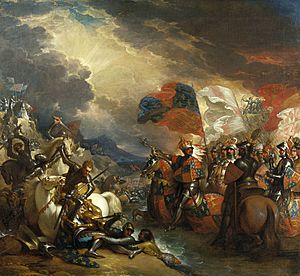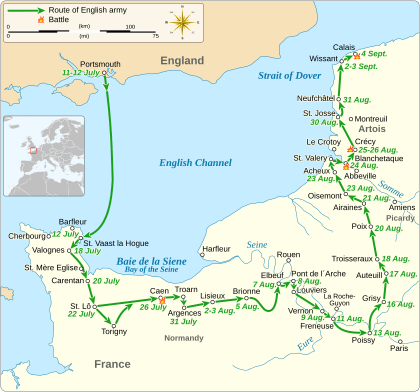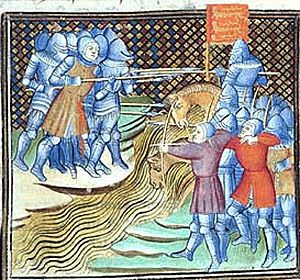Battle of Blanchetaque facts for kids
Quick facts for kids Battle of Blanchetaque |
|||||||
|---|---|---|---|---|---|---|---|
| Part of the Crécy campaign during the Hundred Years' War | |||||||
 Edward III Crossing the Somme by Benjamin West, 1788 |
|||||||
|
|||||||
| Belligerents | |||||||
| Kingdom of England | Kingdom of France | ||||||
| Commanders and leaders | |||||||
| Edward III of England | Godemar I du Fay | ||||||
| Strength | |||||||
| 5,000 (not all engaged) | 3,500 | ||||||
| Casualties and losses | |||||||
| Light | c. 2,000 | ||||||
The Battle of Blanchetaque was a fight between the English army, led by King Edward III, and a French force. It happened on August 24, 1346, near the River Somme in France. This battle was a key part of the Crécy campaign during the early years of the Hundred Years' War.
Before the battle, the English army had landed in France and was marching through rich French lands. They were burning towns and taking valuable goods. King Edward III hoped to meet up with his allies, the Flemish, who were invading from Flanders. However, the French king, Philip VI, was trying to stop them. He made sure all bridges and river crossings over the Somme River were guarded. This trapped the English army, as the French had also removed all food supplies from the area.
King Edward heard about a special river crossing called Blanchetaque, which means "white ford" because of the white stones on its bed. It was only 10 miles (16 km) from the sea. Edward led his army there and found it guarded by a French force under Godemar du Fay. Once the tide went out, making the water shallow enough, English longbowmen bravely waded into the river. They fought against French crossbowmen and cavalry. The English won the battle, pushing the French back. This victory allowed the English army to cross the Somme River. Just two days later, the main French army was defeated at the famous Battle of Crécy.
Why the War Started
For a long time, English kings also held land in France. This made them vassals, or loyal subjects, to the French kings. This situation often caused arguments between the two kingdoms. By 1337, England only held Gascony in southwest France and Ponthieu in northern France.
In 1337, King Philip VI of France decided to take back Gascony from King Edward III of England. He said Edward wasn't following his duties as a vassal. This event officially started the Hundred Years' War.
In 1345, King Edward III planned a big attack on France. He wanted to attack from three different directions. The French knew Edward would likely focus on northern France. So, they sent most of their soldiers there. However, Edward's main fleet was delayed by a storm. Meanwhile, an English force in Gascony, led by Henry, Earl of Derby, had great success. They won two major battles and captured many French towns.
In 1346, the French sent a huge army to Gascony to fight back. This army, led by John, Duke of Normandy, laid siege to the important town of Aiguillon. This meant most of France's military power was focused far away in the south.
Edward III used this chance to prepare his own large army. He gathered over 700 ships, the biggest English fleet ever. The French thought Edward would sail to Gascony to help Aiguillon. But Edward surprised them by sailing to northern France instead.
The March to Blanchetaque
On July 11, 1346, Edward's fleet left England. The next day, they landed at Saint-Vaast-la-Hougue in Normandy, France. The English army had about 15,000 soldiers, including English, Welsh, German, and Breton fighters.
The English army marched south, completely surprising the French. Edward's goal was to carry out a "chevauchée." This was a large-scale raid to damage France's wealth and lower its people's spirits. His soldiers burned towns like Carentan and Caen, and took everything they could find. The English fleet sailed alongside, also destroying the land near the coast and capturing French ships.
The French were in a tough spot. Their main army was stuck at the siege of Aiguillon. Edward was freely moving through France, causing a lot of damage. King Philip VI quickly gathered an army in northern France. He tried to stop Edward, but his army was not well-organized.
On August 7, the English army reached the River Seine, close to Paris. Edward refused to stop for peace talks, wanting to keep moving. By August 12, Edward's army was near Poissy, just 20 miles (32 km) from Paris. They had left a wide path of destruction behind them.
On August 16, Edward burned Poissy and marched north. The French had used a "scorched earth" tactic. This meant they removed all food supplies, forcing the English to spread out to find food. This slowed the English down a lot. King Philip reached the River Somme a day before Edward. He set up his army at Amiens and sent soldiers to guard every bridge and river crossing between Amiens and the sea. The English were now trapped in an area with no food. The French army then moved towards the English, ready to fight.
Edward was determined to cross the Somme. He tried to attack at several points but failed. English supplies were running out, and the soldiers were tired and hungry. On the evening of August 24, Edward learned about a ford called Blanchetaque, only 4 miles (6 km) away. He immediately moved his entire army towards it.
The Battle at the Ford
When the English arrived at the river, they saw that the French had strongly defended the ford. About 3,500 French soldiers, including 500 men-at-arms (knights and heavily armed soldiers) and many mercenary crossbowmen, were waiting. They were led by Godemar du Fay, a skilled French general.
The ford was very wide, about 2,000 yards (1,800 meters). Because it was close to the sea, the water level changed a lot with the tides. It could only be crossed for a few hours twice a day. When the English arrived at dawn, the tide was high. They had to wait several hours for the water to drop. The French army was lined up in three rows on the far bank, with their best soldiers in the middle.
Around 9:00 AM, a group of English longbowmen, led by Hugh, Baron Despenser, started to cross the ford. They walked 12 abreast on the narrow path. French crossbowmen began shooting at them. But the longbowmen kept going until the water was shallow enough for them to shoot back. The longbowmen could shoot three times faster than the crossbowmen. Their arrows were also more effective.
As the French crossbowmen struggled, some French men-at-arms rode their horses into the river to attack the longbowmen. But the English had their own mounted men-at-arms waiting behind their archers. These English knights, probably led by William, Earl of Northampton, moved forward and fought the French at the water's edge.
The fighting was messy, but the English pushed the French back onto their own riverbank. More English soldiers joined the fight. After a short, fierce struggle, the French broke and ran towards Abbeville, 6 miles (10 km) away. Most of the French knights and nobles, who were on horseback, managed to escape. However, the French foot soldiers could not outrun the English cavalry and suffered heavy losses. It was common at the time for common soldiers to be killed without mercy. Godemar du Fay was badly hurt but escaped.
About an hour and a half after the French lines broke, the entire English army had crossed the ford. The main French army was close behind, but the tide was coming in again. The French decided not to try crossing the river. The next morning, they went back to the bridge at Abbeville, which was a 12-mile (19 km) detour. It's believed that about 2,000 French soldiers were killed in the battle or during their escape. English losses were very light.
What Happened Next?
After the French left, King Edward marched his army 9 miles (14 km) to Crécy-en-Ponthieu. There, he set up a strong defensive position. The French had been so sure the English couldn't cross the Somme that they hadn't removed food from the area. So, the English found plenty of food and supplies.
On August 26, just two days after Blanchetaque, the main French army under King Philip VI was completely defeated at the Battle of Crécy. This was a huge loss for the French. Edward then ended his campaign by laying siege to Calais. The town fell after twelve months. This gave England an important port in northern France, which they held for 200 years.



